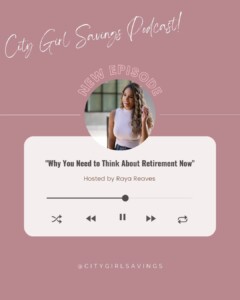When I got my first job out of college, I remember opting in to my company’s 401k plan. They were offering to match up to 5%, so I contributed 5%. I didn’t know much about what I was doing (like most young working adults), but I knew it was a smart move. Fast forward to 10 years later, and my 401k plan had a balance over six-figures! Over the course of time, I worked to familiarize myself with my retirement plan, and it paid off.
I recently read an article in the Wall Street Journal that said Millennials are saving more for retirement than any other generation because most employers automatically enroll employees into their retirement plan. Thank goodness for that! However, you could be saving for retirement and completely unaware! Let’s change that. I’m sharing 6 ways to familiarize yourself with your retirement plan. When you know better, you can do better.
6 Ways to Familiarize Yourself with Your Retirement Plan
#1 Check Your Pay Stub
Want to know if you’re contributing to a retirement plan, or if your employer is contributing on your behalf? Check your pay stub! You’ll see a Pre-Tax or After-Tax deduction line item showing if a portion of your paycheck went to a retirement plan. You can also check under the section labeled “Employer Paid Contributions”. If your company was contributing on your behalf, you would see the amount listed.
Since everyone has access to their pay stubs, this would be the quickest way to determine if you’re contributing to a retirement plan. You’ll also see exactly how much is being contributed each pay period.
#2 Access Your Retirement Plan Portal
Once you’ve determined that you are (or are not) contributing to a retirement plan, you can access your retirement plan portal to get more details about your retirement plan. If you’re unsure where to find this information, reach out to HR or check your Employee Handbook. Both of those resources should get you the information you’re looking for.
After accessing your retirement plan portal, you’ll have the ability to change your contribution rates, adjust your investments, access statements, and read important retirement plan information. You may not be in this portal often, but knowing how to get to it is critical.
#3 Understand Your Current Investments
Nine times out of ten, if you’re contributing to a retirement plan but didn’t select your own investments, you were placed in a “Target Date Fund”. You’ll see something on your statement that says, “Target Date Retirement 2050”. That means your plan investment is a target date fund. That’s not a bad thing, but it means you could be missing out on better investment opportunities in your plan.
#4 Know Your Investment Options
Once you know what your current investments are (by looking at your statement), your next course of action should be to find out what investment options are available to you. When I started diving into my previous company’s 401k plan, I found myself in a Target Date Fund. After doing some research, I changed my 401k investment options and my earning potential skyrocketed.
You don’t have to make any changes to your investments right away, but it’s beneficial to know what your investment options are. That way, when you are ready to make changes, you know what options you have to choose from. You can also work with a plan advisor to help. Which leads me to the next way to familiarize yourself with your retirement plan.
#5 Take Advantage of Plan Advisor Calls
Most retirement plans give people the option to speak with an advisor or customer service representative. Take advantage of this! These people can help you understand your plan, contributions and guide you to changing your investments to a mix that’s best for you and your situation. You’ll find contact information through your retirement plan portal. Some companies even give you the option to have quarterly check-ins.
#6 Review Your Statements
The final way to familiarize yourself with your retirement plan is to look at your statements! Most retirement plan statements come out monthly or quarterly. Whatever the cadence, make sure you’re always looking at them. You’ll see details like how your individual investments are performing, how much you and your employer contributed, and how your overall plan is performing (your rate of return).
While performance is tied to the market and how well it’s performing, over time, you’ll want to see an increase in your plan balance. That means your contributions and investments are growing. I actually have my retirement plan (a Roth IRA now) as a line item in my net worth tracking. Since it’s an asset, I track its growth month over month.
Related: 8 Things to Know About Your 401k Plan
Each of the ways above to familiarize yourself with your 401k plan should not take long to implement. Understanding where your money is going and why is such an important part of managing what you make. There’s no doubt that saving for retirement is a fantastic way to build wealth, but I want you to know about your plan! I want you to know your investments and how they’re performing. That can only happen when you take the time to review the information available to you.
Are you contributing to a retirement plan? Were you already aware of some of the things I shared today? Drop a comment below to share!
-Raya
The CGS Team






